Network Design for AML Company
VerifiedAdded on 2023/01/19
|11
|1552
|100
AI Summary
This paper discusses the network design for AML Company, including current network analysis, description and analysis of the current set-up, and proposed GPON design.
Contribute Materials
Your contribution can guide someone’s learning journey. Share your
documents today.

NETWORK DESIGN 1
NETWORK DESIGN
(Student’s Name)
(Professor’s name)
(Course)
(Date)
Table of Contents
NETWORK DESIGN
(Student’s Name)
(Professor’s name)
(Course)
(Date)
Table of Contents
Secure Best Marks with AI Grader
Need help grading? Try our AI Grader for instant feedback on your assignments.
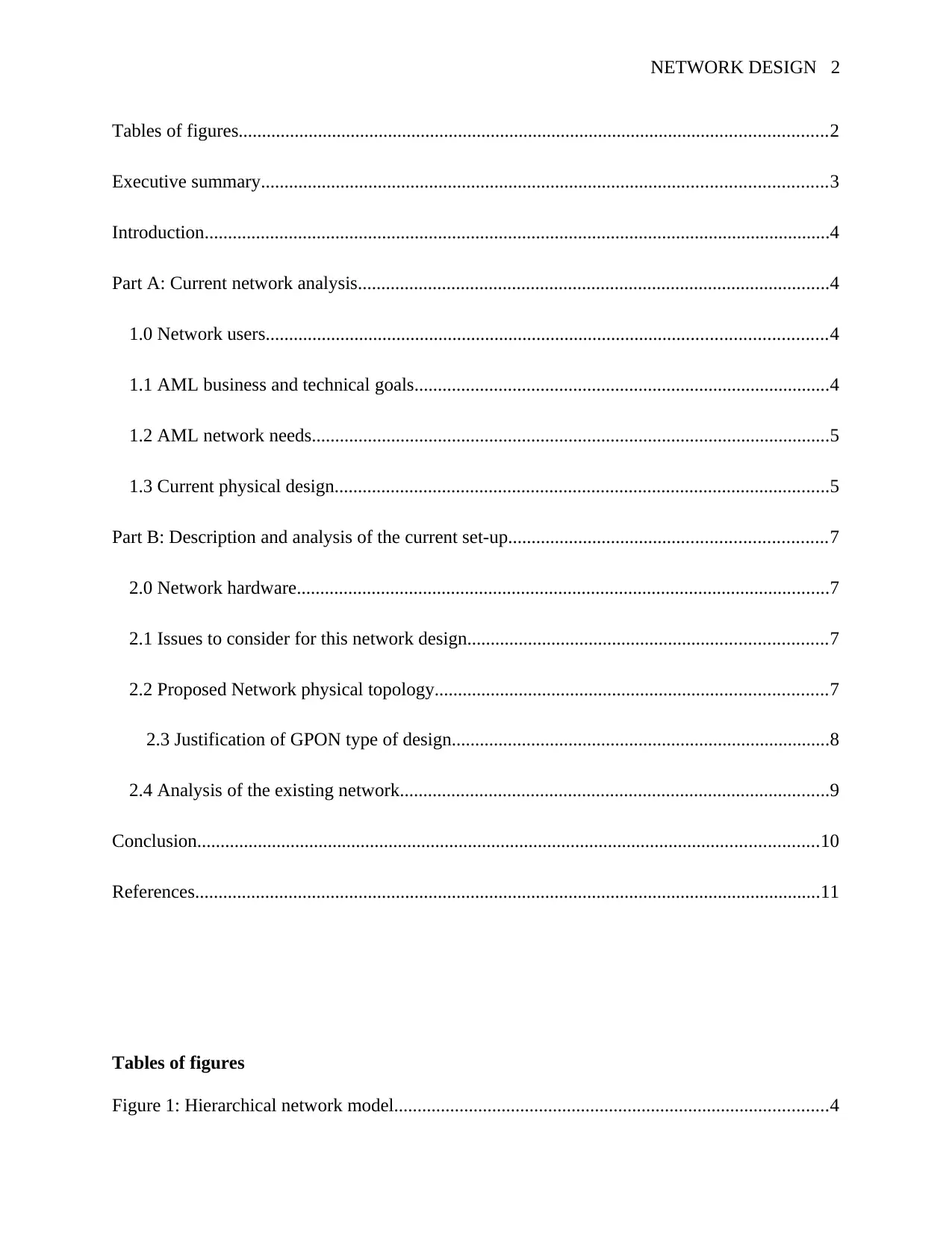
NETWORK DESIGN 2
Tables of figures..............................................................................................................................2
Executive summary.........................................................................................................................3
Introduction......................................................................................................................................4
Part A: Current network analysis.....................................................................................................4
1.0 Network users........................................................................................................................4
1.1 AML business and technical goals.........................................................................................4
1.2 AML network needs...............................................................................................................5
1.3 Current physical design..........................................................................................................5
Part B: Description and analysis of the current set-up....................................................................7
2.0 Network hardware..................................................................................................................7
2.1 Issues to consider for this network design.............................................................................7
2.2 Proposed Network physical topology....................................................................................7
2.3 Justification of GPON type of design.................................................................................8
2.4 Analysis of the existing network............................................................................................9
Conclusion.....................................................................................................................................10
References......................................................................................................................................11
Tables of figures
Figure 1: Hierarchical network model.............................................................................................4
Tables of figures..............................................................................................................................2
Executive summary.........................................................................................................................3
Introduction......................................................................................................................................4
Part A: Current network analysis.....................................................................................................4
1.0 Network users........................................................................................................................4
1.1 AML business and technical goals.........................................................................................4
1.2 AML network needs...............................................................................................................5
1.3 Current physical design..........................................................................................................5
Part B: Description and analysis of the current set-up....................................................................7
2.0 Network hardware..................................................................................................................7
2.1 Issues to consider for this network design.............................................................................7
2.2 Proposed Network physical topology....................................................................................7
2.3 Justification of GPON type of design.................................................................................8
2.4 Analysis of the existing network............................................................................................9
Conclusion.....................................................................................................................................10
References......................................................................................................................................11
Tables of figures
Figure 1: Hierarchical network model.............................................................................................4
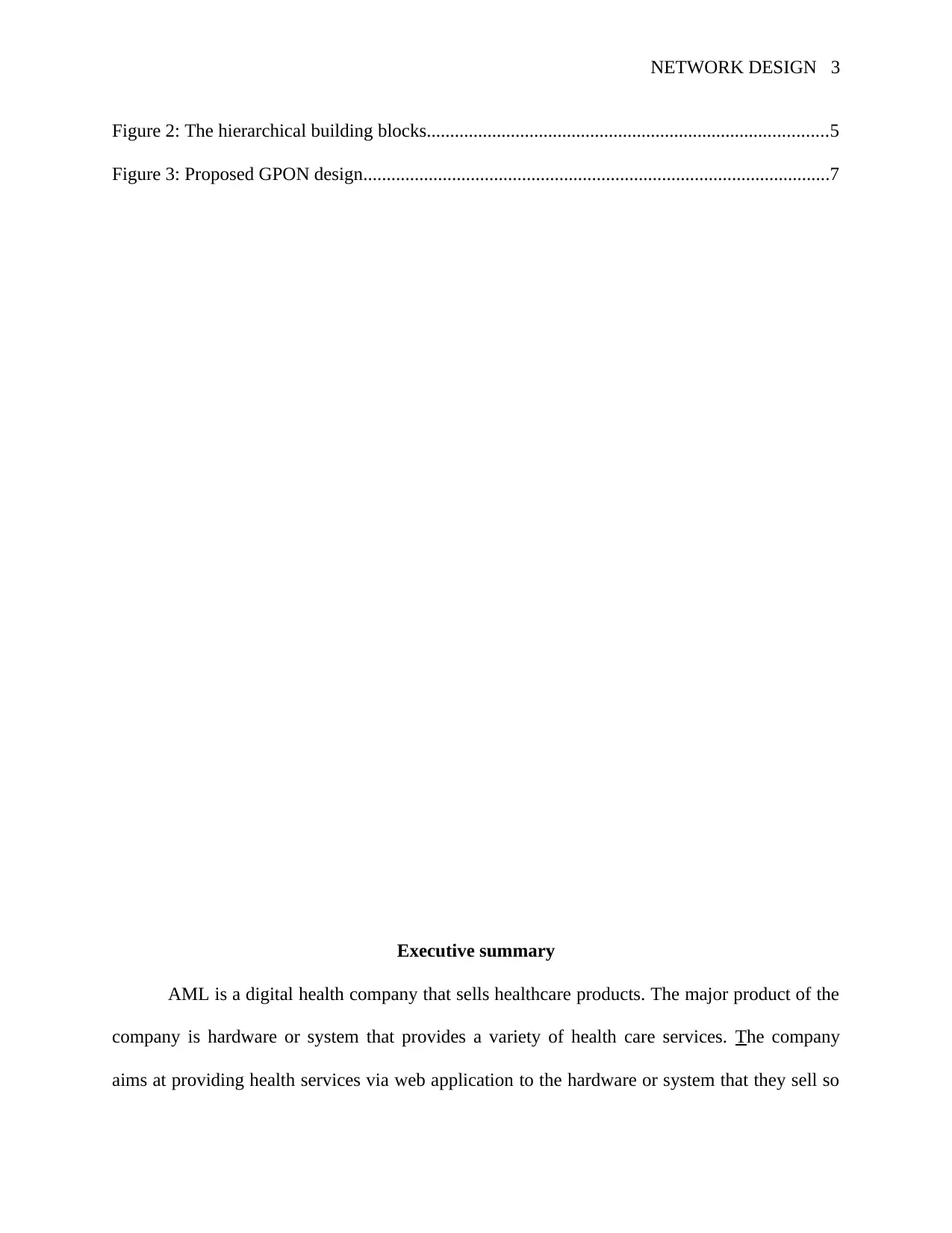
NETWORK DESIGN 3
Figure 2: The hierarchical building blocks......................................................................................5
Figure 3: Proposed GPON design....................................................................................................7
Executive summary
AML is a digital health company that sells healthcare products. The major product of the
company is hardware or system that provides a variety of health care services. The company
aims at providing health services via web application to the hardware or system that they sell so
Figure 2: The hierarchical building blocks......................................................................................5
Figure 3: Proposed GPON design....................................................................................................7
Executive summary
AML is a digital health company that sells healthcare products. The major product of the
company is hardware or system that provides a variety of health care services. The company
aims at providing health services via web application to the hardware or system that they sell so
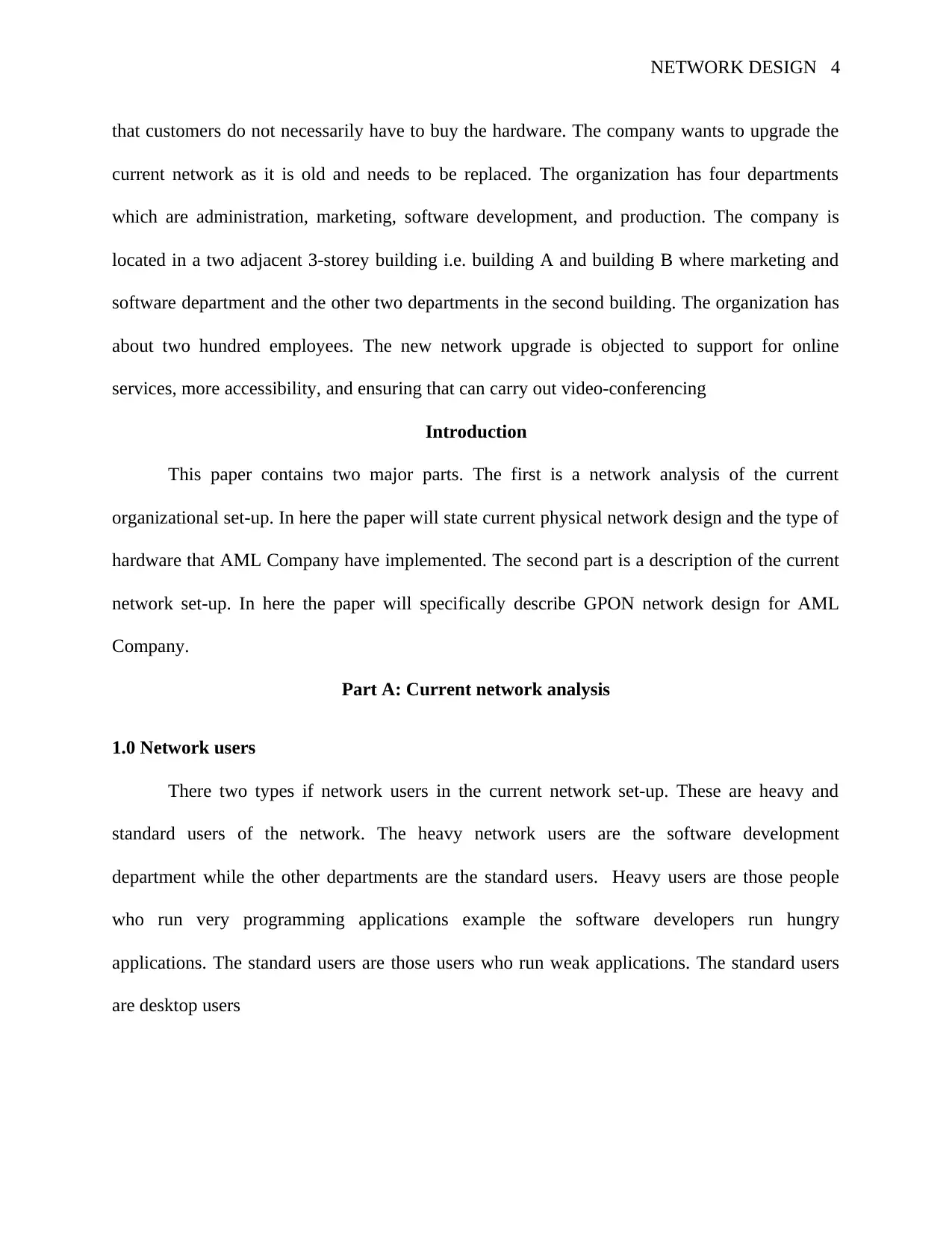
NETWORK DESIGN 4
that customers do not necessarily have to buy the hardware. The company wants to upgrade the
current network as it is old and needs to be replaced. The organization has four departments
which are administration, marketing, software development, and production. The company is
located in a two adjacent 3-storey building i.e. building A and building B where marketing and
software department and the other two departments in the second building. The organization has
about two hundred employees. The new network upgrade is objected to support for online
services, more accessibility, and ensuring that can carry out video-conferencing
Introduction
This paper contains two major parts. The first is a network analysis of the current
organizational set-up. In here the paper will state current physical network design and the type of
hardware that AML Company have implemented. The second part is a description of the current
network set-up. In here the paper will specifically describe GPON network design for AML
Company.
Part A: Current network analysis
1.0 Network users
There two types if network users in the current network set-up. These are heavy and
standard users of the network. The heavy network users are the software development
department while the other departments are the standard users. Heavy users are those people
who run very programming applications example the software developers run hungry
applications. The standard users are those users who run weak applications. The standard users
are desktop users
that customers do not necessarily have to buy the hardware. The company wants to upgrade the
current network as it is old and needs to be replaced. The organization has four departments
which are administration, marketing, software development, and production. The company is
located in a two adjacent 3-storey building i.e. building A and building B where marketing and
software department and the other two departments in the second building. The organization has
about two hundred employees. The new network upgrade is objected to support for online
services, more accessibility, and ensuring that can carry out video-conferencing
Introduction
This paper contains two major parts. The first is a network analysis of the current
organizational set-up. In here the paper will state current physical network design and the type of
hardware that AML Company have implemented. The second part is a description of the current
network set-up. In here the paper will specifically describe GPON network design for AML
Company.
Part A: Current network analysis
1.0 Network users
There two types if network users in the current network set-up. These are heavy and
standard users of the network. The heavy network users are the software development
department while the other departments are the standard users. Heavy users are those people
who run very programming applications example the software developers run hungry
applications. The standard users are those users who run weak applications. The standard users
are desktop users
Secure Best Marks with AI Grader
Need help grading? Try our AI Grader for instant feedback on your assignments.
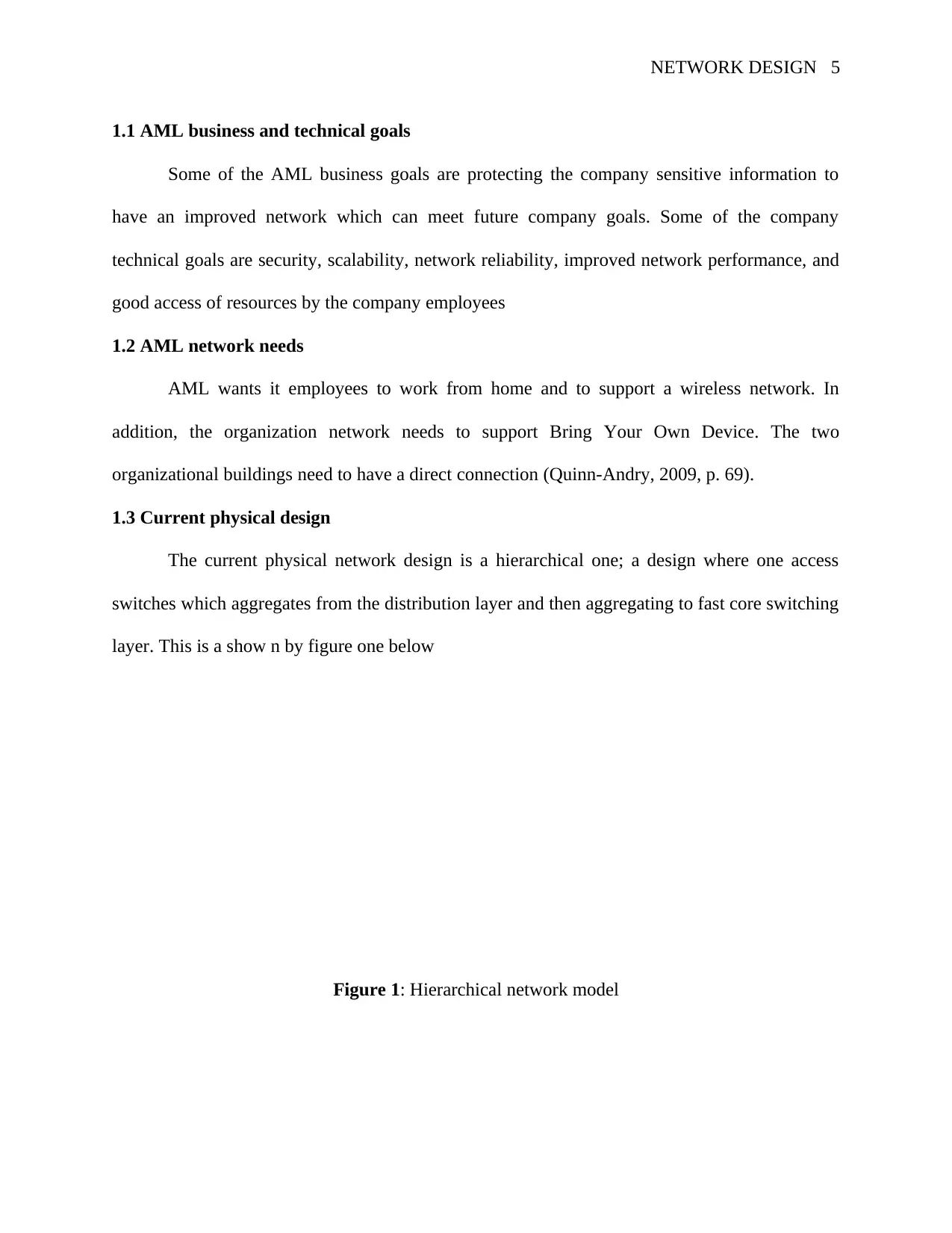
NETWORK DESIGN 5
1.1 AML business and technical goals
Some of the AML business goals are protecting the company sensitive information to
have an improved network which can meet future company goals. Some of the company
technical goals are security, scalability, network reliability, improved network performance, and
good access of resources by the company employees
1.2 AML network needs
AML wants it employees to work from home and to support a wireless network. In
addition, the organization network needs to support Bring Your Own Device. The two
organizational buildings need to have a direct connection (Quinn-Andry, 2009, p. 69).
1.3 Current physical design
The current physical network design is a hierarchical one; a design where one access
switches which aggregates from the distribution layer and then aggregating to fast core switching
layer. This is a show n by figure one below
Figure 1: Hierarchical network model
1.1 AML business and technical goals
Some of the AML business goals are protecting the company sensitive information to
have an improved network which can meet future company goals. Some of the company
technical goals are security, scalability, network reliability, improved network performance, and
good access of resources by the company employees
1.2 AML network needs
AML wants it employees to work from home and to support a wireless network. In
addition, the organization network needs to support Bring Your Own Device. The two
organizational buildings need to have a direct connection (Quinn-Andry, 2009, p. 69).
1.3 Current physical design
The current physical network design is a hierarchical one; a design where one access
switches which aggregates from the distribution layer and then aggregating to fast core switching
layer. This is a show n by figure one below
Figure 1: Hierarchical network model
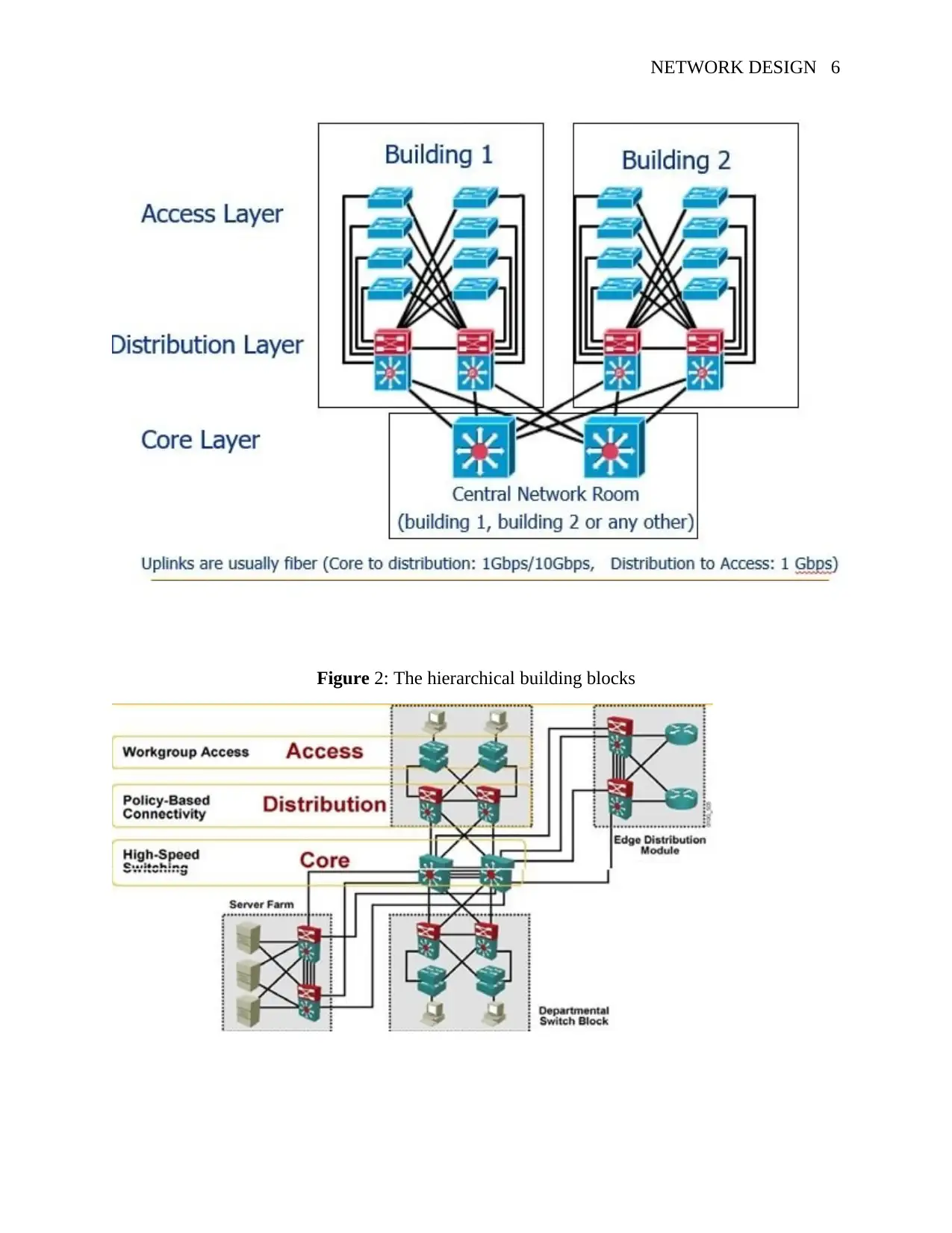
NETWORK DESIGN 6
Figure 2: The hierarchical building blocks
Figure 2: The hierarchical building blocks
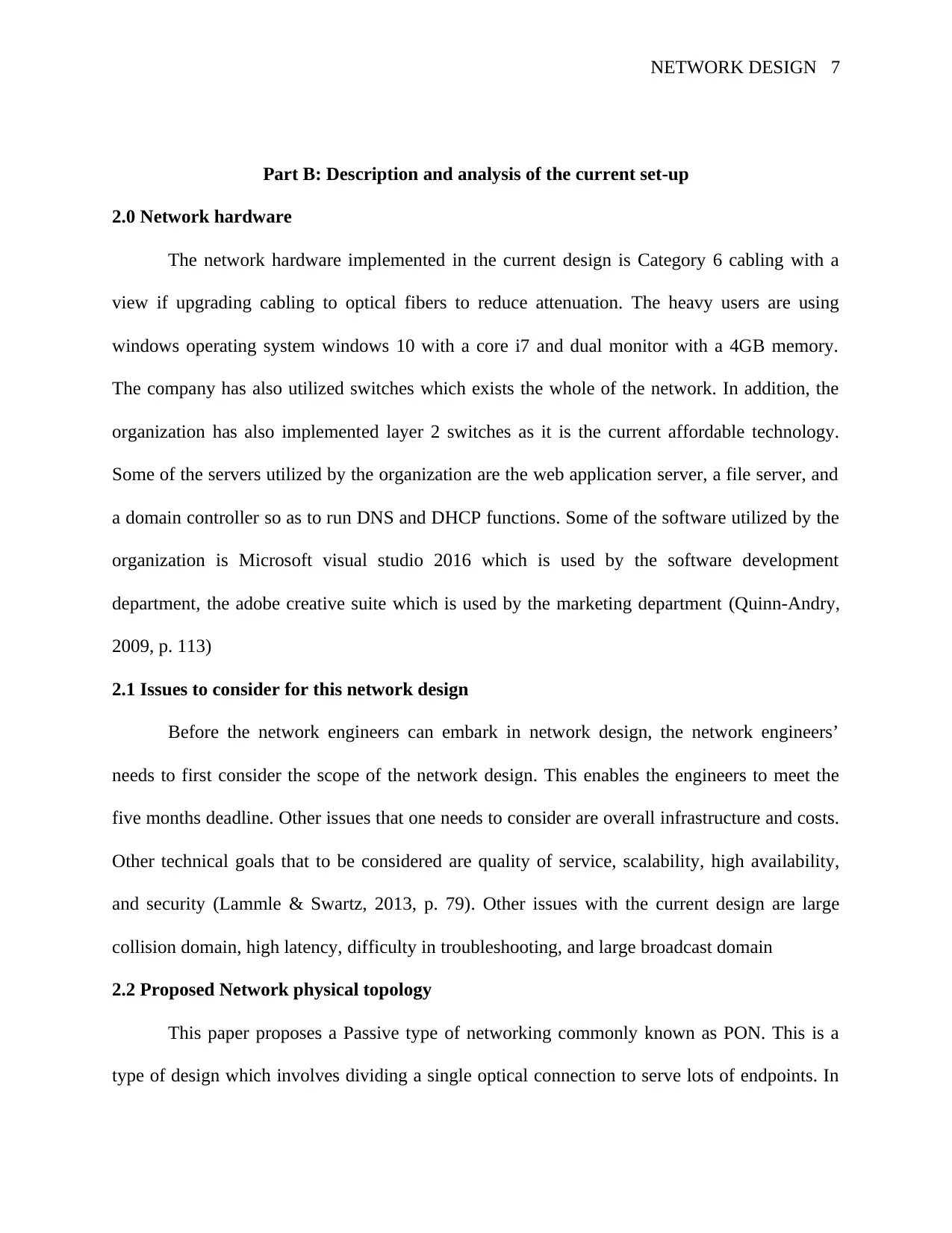
NETWORK DESIGN 7
Part B: Description and analysis of the current set-up
2.0 Network hardware
The network hardware implemented in the current design is Category 6 cabling with a
view if upgrading cabling to optical fibers to reduce attenuation. The heavy users are using
windows operating system windows 10 with a core i7 and dual monitor with a 4GB memory.
The company has also utilized switches which exists the whole of the network. In addition, the
organization has also implemented layer 2 switches as it is the current affordable technology.
Some of the servers utilized by the organization are the web application server, a file server, and
a domain controller so as to run DNS and DHCP functions. Some of the software utilized by the
organization is Microsoft visual studio 2016 which is used by the software development
department, the adobe creative suite which is used by the marketing department (Quinn-Andry,
2009, p. 113)
2.1 Issues to consider for this network design
Before the network engineers can embark in network design, the network engineers’
needs to first consider the scope of the network design. This enables the engineers to meet the
five months deadline. Other issues that one needs to consider are overall infrastructure and costs.
Other technical goals that to be considered are quality of service, scalability, high availability,
and security (Lammle & Swartz, 2013, p. 79). Other issues with the current design are large
collision domain, high latency, difficulty in troubleshooting, and large broadcast domain
2.2 Proposed Network physical topology
This paper proposes a Passive type of networking commonly known as PON. This is a
type of design which involves dividing a single optical connection to serve lots of endpoints. In
Part B: Description and analysis of the current set-up
2.0 Network hardware
The network hardware implemented in the current design is Category 6 cabling with a
view if upgrading cabling to optical fibers to reduce attenuation. The heavy users are using
windows operating system windows 10 with a core i7 and dual monitor with a 4GB memory.
The company has also utilized switches which exists the whole of the network. In addition, the
organization has also implemented layer 2 switches as it is the current affordable technology.
Some of the servers utilized by the organization are the web application server, a file server, and
a domain controller so as to run DNS and DHCP functions. Some of the software utilized by the
organization is Microsoft visual studio 2016 which is used by the software development
department, the adobe creative suite which is used by the marketing department (Quinn-Andry,
2009, p. 113)
2.1 Issues to consider for this network design
Before the network engineers can embark in network design, the network engineers’
needs to first consider the scope of the network design. This enables the engineers to meet the
five months deadline. Other issues that one needs to consider are overall infrastructure and costs.
Other technical goals that to be considered are quality of service, scalability, high availability,
and security (Lammle & Swartz, 2013, p. 79). Other issues with the current design are large
collision domain, high latency, difficulty in troubleshooting, and large broadcast domain
2.2 Proposed Network physical topology
This paper proposes a Passive type of networking commonly known as PON. This is a
type of design which involves dividing a single optical connection to serve lots of endpoints. In
Paraphrase This Document
Need a fresh take? Get an instant paraphrase of this document with our AI Paraphraser
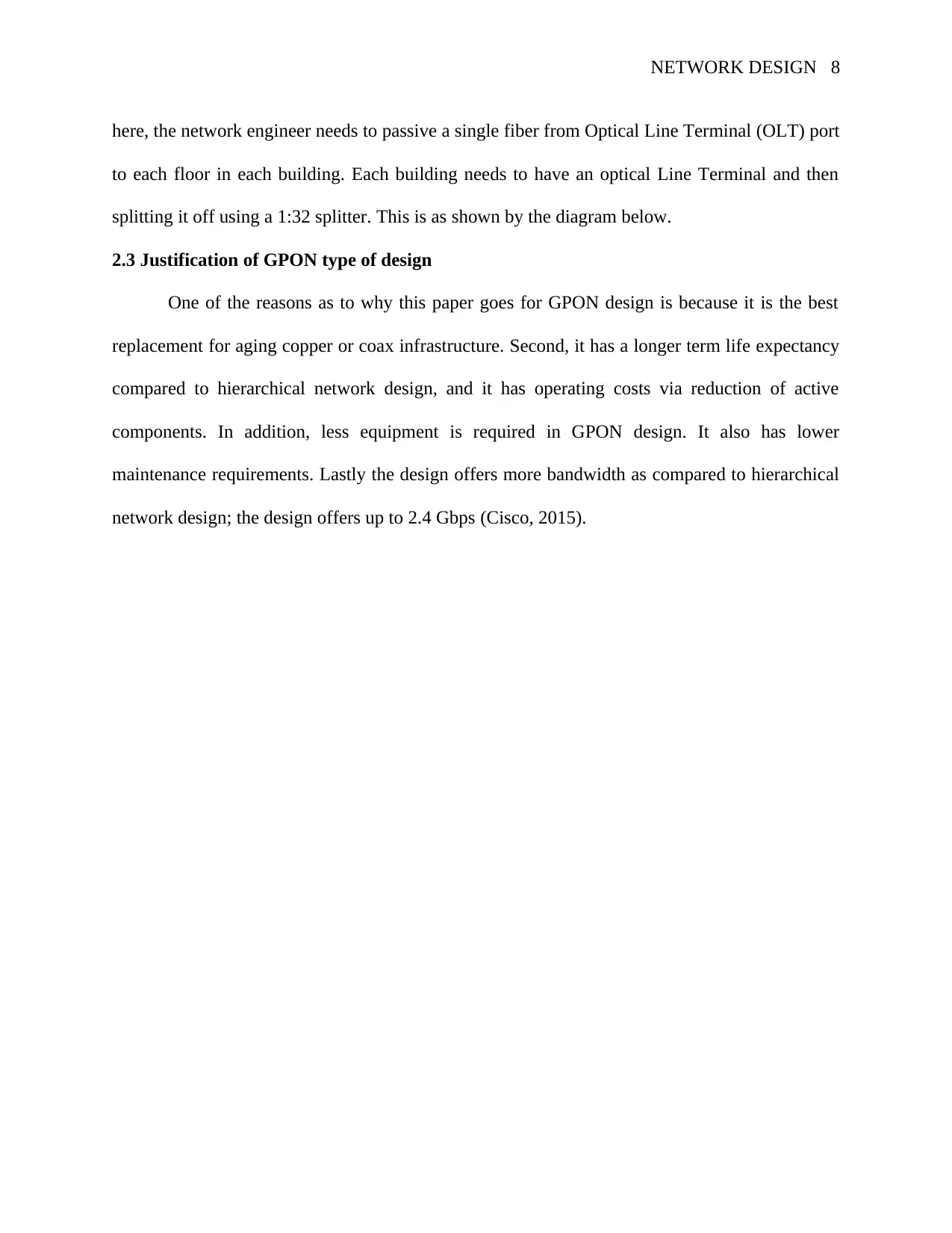
NETWORK DESIGN 8
here, the network engineer needs to passive a single fiber from Optical Line Terminal (OLT) port
to each floor in each building. Each building needs to have an optical Line Terminal and then
splitting it off using a 1:32 splitter. This is as shown by the diagram below.
2.3 Justification of GPON type of design
One of the reasons as to why this paper goes for GPON design is because it is the best
replacement for aging copper or coax infrastructure. Second, it has a longer term life expectancy
compared to hierarchical network design, and it has operating costs via reduction of active
components. In addition, less equipment is required in GPON design. It also has lower
maintenance requirements. Lastly the design offers more bandwidth as compared to hierarchical
network design; the design offers up to 2.4 Gbps (Cisco, 2015).
here, the network engineer needs to passive a single fiber from Optical Line Terminal (OLT) port
to each floor in each building. Each building needs to have an optical Line Terminal and then
splitting it off using a 1:32 splitter. This is as shown by the diagram below.
2.3 Justification of GPON type of design
One of the reasons as to why this paper goes for GPON design is because it is the best
replacement for aging copper or coax infrastructure. Second, it has a longer term life expectancy
compared to hierarchical network design, and it has operating costs via reduction of active
components. In addition, less equipment is required in GPON design. It also has lower
maintenance requirements. Lastly the design offers more bandwidth as compared to hierarchical
network design; the design offers up to 2.4 Gbps (Cisco, 2015).
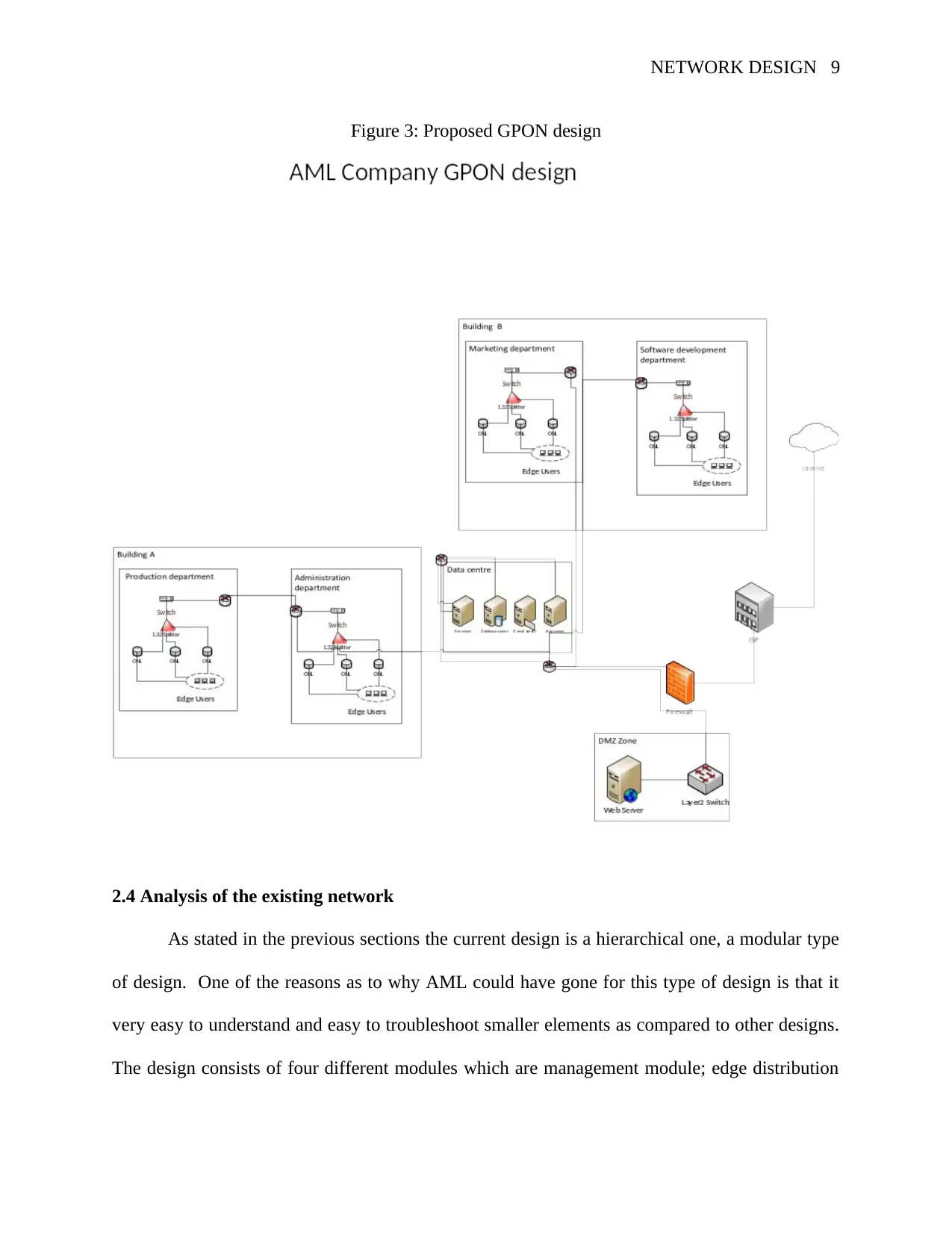
NETWORK DESIGN 9
Figure 3: Proposed GPON design
2.4 Analysis of the existing network
As stated in the previous sections the current design is a hierarchical one, a modular type
of design. One of the reasons as to why AML could have gone for this type of design is that it
very easy to understand and easy to troubleshoot smaller elements as compared to other designs.
The design consists of four different modules which are management module; edge distribution
Figure 3: Proposed GPON design
2.4 Analysis of the existing network
As stated in the previous sections the current design is a hierarchical one, a modular type
of design. One of the reasons as to why AML could have gone for this type of design is that it
very easy to understand and easy to troubleshoot smaller elements as compared to other designs.
The design consists of four different modules which are management module; edge distribution
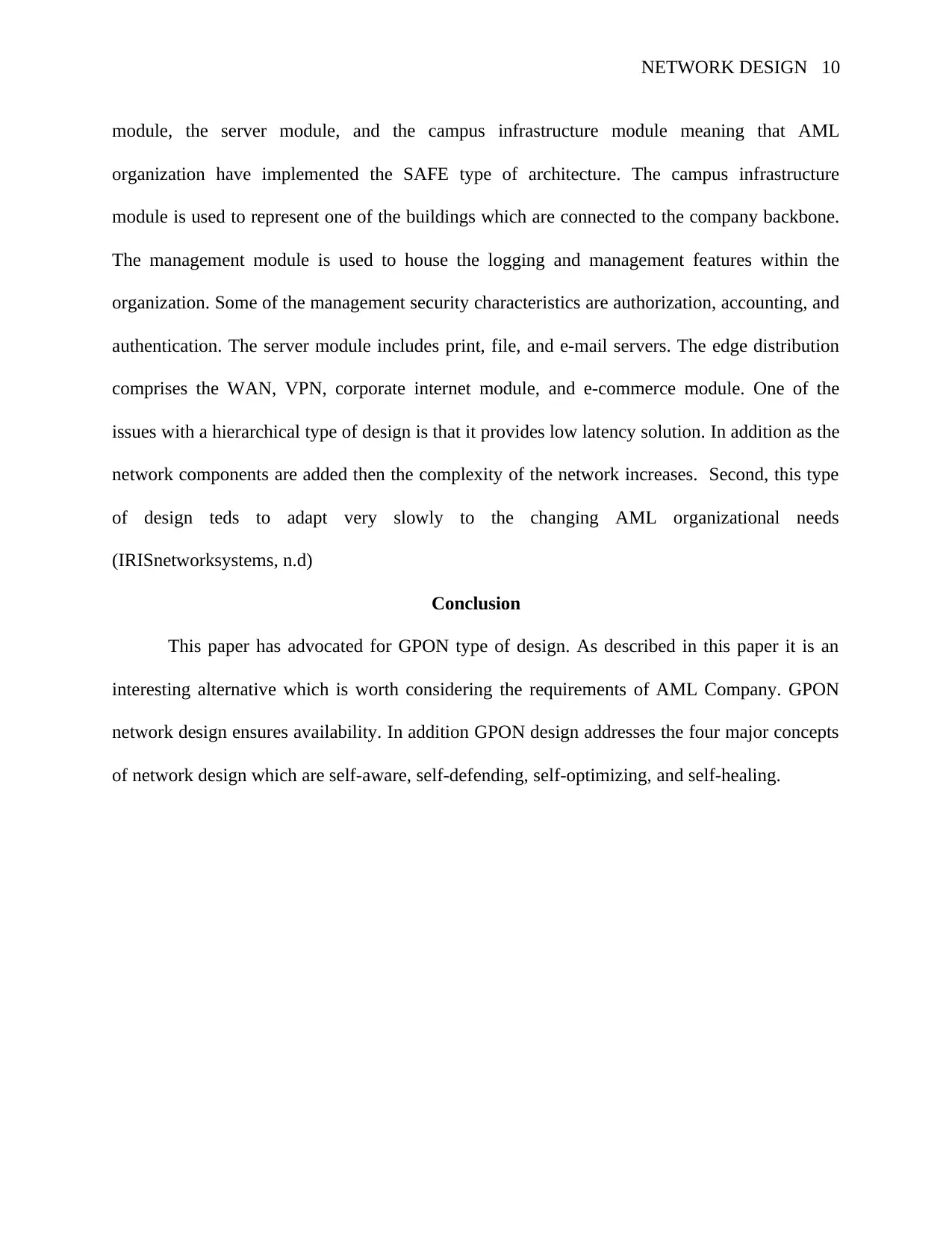
NETWORK DESIGN 10
module, the server module, and the campus infrastructure module meaning that AML
organization have implemented the SAFE type of architecture. The campus infrastructure
module is used to represent one of the buildings which are connected to the company backbone.
The management module is used to house the logging and management features within the
organization. Some of the management security characteristics are authorization, accounting, and
authentication. The server module includes print, file, and e-mail servers. The edge distribution
comprises the WAN, VPN, corporate internet module, and e-commerce module. One of the
issues with a hierarchical type of design is that it provides low latency solution. In addition as the
network components are added then the complexity of the network increases. Second, this type
of design teds to adapt very slowly to the changing AML organizational needs
(IRISnetworksystems, n.d)
Conclusion
This paper has advocated for GPON type of design. As described in this paper it is an
interesting alternative which is worth considering the requirements of AML Company. GPON
network design ensures availability. In addition GPON design addresses the four major concepts
of network design which are self-aware, self-defending, self-optimizing, and self-healing.
module, the server module, and the campus infrastructure module meaning that AML
organization have implemented the SAFE type of architecture. The campus infrastructure
module is used to represent one of the buildings which are connected to the company backbone.
The management module is used to house the logging and management features within the
organization. Some of the management security characteristics are authorization, accounting, and
authentication. The server module includes print, file, and e-mail servers. The edge distribution
comprises the WAN, VPN, corporate internet module, and e-commerce module. One of the
issues with a hierarchical type of design is that it provides low latency solution. In addition as the
network components are added then the complexity of the network increases. Second, this type
of design teds to adapt very slowly to the changing AML organizational needs
(IRISnetworksystems, n.d)
Conclusion
This paper has advocated for GPON type of design. As described in this paper it is an
interesting alternative which is worth considering the requirements of AML Company. GPON
network design ensures availability. In addition GPON design addresses the four major concepts
of network design which are self-aware, self-defending, self-optimizing, and self-healing.
Secure Best Marks with AI Grader
Need help grading? Try our AI Grader for instant feedback on your assignments.
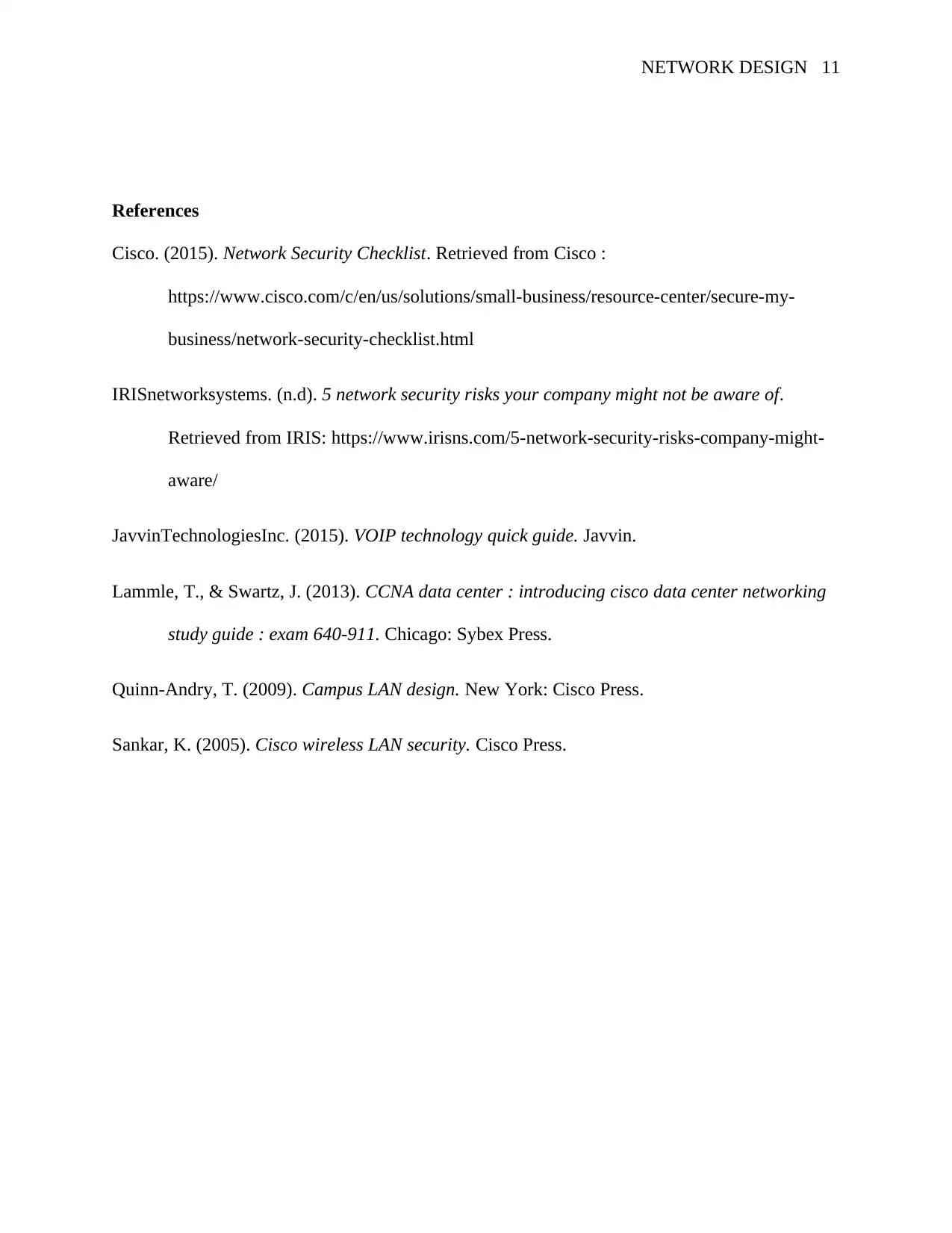
NETWORK DESIGN 11
References
Cisco. (2015). Network Security Checklist. Retrieved from Cisco :
https://www.cisco.com/c/en/us/solutions/small-business/resource-center/secure-my-
business/network-security-checklist.html
IRISnetworksystems. (n.d). 5 network security risks your company might not be aware of.
Retrieved from IRIS: https://www.irisns.com/5-network-security-risks-company-might-
aware/
JavvinTechnologiesInc. (2015). VOIP technology quick guide. Javvin.
Lammle, T., & Swartz, J. (2013). CCNA data center : introducing cisco data center networking
study guide : exam 640-911. Chicago: Sybex Press.
Quinn-Andry, T. (2009). Campus LAN design. New York: Cisco Press.
Sankar, K. (2005). Cisco wireless LAN security. Cisco Press.
References
Cisco. (2015). Network Security Checklist. Retrieved from Cisco :
https://www.cisco.com/c/en/us/solutions/small-business/resource-center/secure-my-
business/network-security-checklist.html
IRISnetworksystems. (n.d). 5 network security risks your company might not be aware of.
Retrieved from IRIS: https://www.irisns.com/5-network-security-risks-company-might-
aware/
JavvinTechnologiesInc. (2015). VOIP technology quick guide. Javvin.
Lammle, T., & Swartz, J. (2013). CCNA data center : introducing cisco data center networking
study guide : exam 640-911. Chicago: Sybex Press.
Quinn-Andry, T. (2009). Campus LAN design. New York: Cisco Press.
Sankar, K. (2005). Cisco wireless LAN security. Cisco Press.
1 out of 11
Related Documents
Your All-in-One AI-Powered Toolkit for Academic Success.
+13062052269
info@desklib.com
Available 24*7 on WhatsApp / Email
![[object Object]](/_next/static/media/star-bottom.7253800d.svg)
Unlock your academic potential
© 2024 | Zucol Services PVT LTD | All rights reserved.





